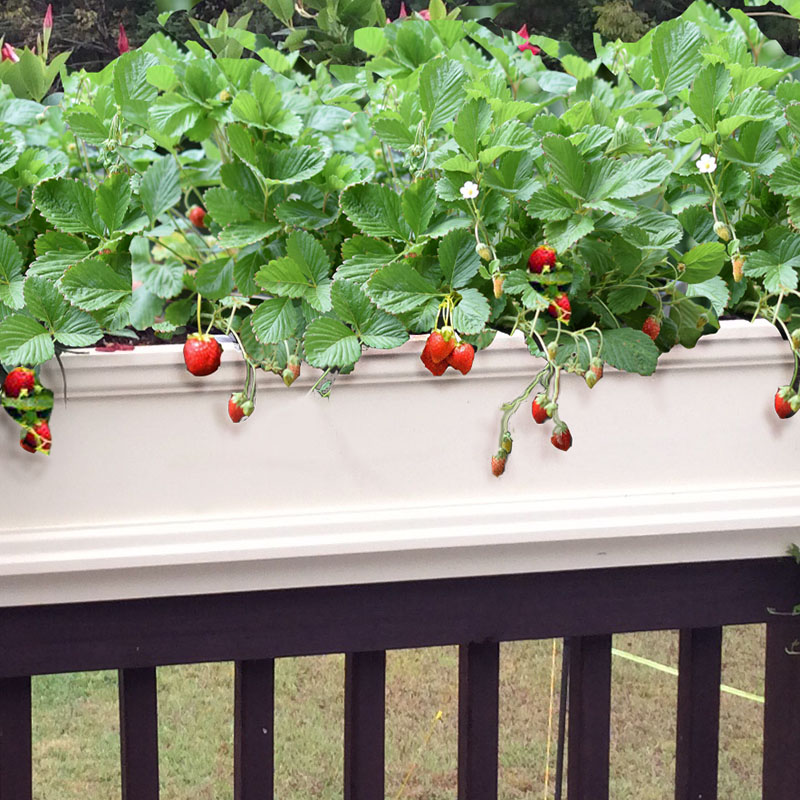How to Grow Strawberries in Planters
Introduction
Strawberries are one of the most popular fruits in the world, enjoyed by people of all ages. Strawberries are not only delicious, but they are also easy to grow and require minimal effort to maintain. Growing strawberries in potting containers or
planters is an ideal solution for those who want to enjoy fresh strawberries all year round, even if they don’t have a garden. This article will provide a comprehensive guide on how to grow strawberries in containers, from selecting the right variety to harvesting and caring for your plants throughout the year.
Selecting the Right Variety
Strawberries come in a variety of sizes and flavors, so it’s important to choose the right variety for your needs. If you’re looking for a high yield of fruit, then June-bearing strawberries are the best choice. These varieties produce a single large crop of berries in the spring and will typically produce a second smaller crop in the fall.
For a continuous supply of fruit throughout the season, choose everbearing or day-neutral varieties. These varieties will produce smaller crops from spring through fall. When selecting strawberries, look for healthy, plump berries with bright red color and a sweet aroma. Be sure to avoid any that are soft, wrinkled, or have signs of mold. Once you’ve selected the right variety, it’s time to move on to the next step – preparing the flower box container.
Types of Strawberry Varieties
Every type is special and delicious but some of the varieties are really famous and have high demand across the world. Here are the varieties one should try to cultivate;
June-Bearing Strawberries: June-bearing strawberries are the most common variety of strawberries. These strawberries produce one large crop in the spring that can be harvested over a period of several weeks. They are ideal for growing in the home garden, as they are hardy, productive, and relatively easy to maintain.
Day-Neutral Strawberries: Day-neutral strawberries are a variety of strawberries that can produce fruit throughout the growing season, from spring through fall. They do not require as much cold weather to produce, so they can be grown in warmer climates. They are usually smaller than June-bearing strawberries and have a milder flavor.
Everbearing Strawberries: Everbearing strawberries are a type of day-neutral strawberry that produces two distinct crops throughout the growing season. The first crop is usually smaller and is produced in the late spring or early summer. The second crop is larger and is produced in the late summer or early fall.
Alpine Strawberries: Alpine strawberries are a type of small, flavorful strawberry that can be grown in containers or in the garden. They are extremely productive and can produce fruit from early summer through early fall. They are also resistant to disease, making them a great choice for the home garden.
Fragaria vesca: Fragaria vesca, also known as wild strawberries, are a type of strawberry that grows wild in many parts of the world. They are smaller and more flavorful than most cultivated varieties, but they are also more difficult to grow in the home garden.
Preparing the Container
When growing strawberries in
window boxes, you’ll need to use a pot that is at least 10 inches in diameter and 12 inches deep. This will provide enough space for the roots to spread out and develop.
Use a potting mix specifically designed for container gardening, as regular garden soil will be too dense and can lead to poor drainage. Add a slow-release fertilizer to the mix to provide the plants with all the nutrients they need throughout the season.
When planting your strawberries, be sure to space the plants at least 6 inches apart to give them enough room to grow. Place the plants in the pot so that the crown – the point where the leaves and roots meet – is just slightly above the soil line. Once your plants are in the pot, add a 2-inch layer of mulch around the plants to help retain moisture and keep weeds at bay.
Types of Containers for Strawberries Planting
There are various types of containers that can be used to plant the strawberries. Listed below are some of the best way to garden strawberries;
Hanging Basket - A hanging basket is an excellent container choice for growing strawberries, as they provide adequate drainage and plenty of air circulation. The basket’s open sides also allow for plenty of light to reach the plants.
Rail Planters - Rail planters are a great option for growing strawberries. They provide a convenient way to garden close to the home so that you don't have to walk all the way to the back yard to enjoy and maintain.
Planter Boxes - Planter boxes are a great option for growing strawberries. They provide plenty of space for the plants to spread out and can be easily moved around.
Pots - Pots are a great option for growing strawberries. They are relatively inexpensive, come in a variety of sizes, and are easy to move around.
Strawberry Pouches - Strawberry pouches are a great option for growing strawberries. They are designed specifically to promote good drainage and air circulation, as well as protect against pests.
Caring for Your Strawberries
Strawberries need plenty of sunlight and water to thrive. Place your strawberry container in an area that receives at least 6 hours of sunlight per day and water the plants regularly, ensuring the soil stays moist but not soggy. You can use a self-watering flower box to help keep your soil moist. As the plants begin to fruit, apply an organic liquid fertilizer every few weeks to encourage healthy growth and optimal fruit production.
It’s also important to keep an eye out for pests and diseases, such as aphids, slugs, and powdery mildew. If you notice any signs of infestation, treat the plants with an organic insecticide or fungicide to prevent further damage.
Steps to Care the Strawberries
Watering: Strawberries require regular watering to maintain healthy growth. Water the plants deeply once or twice a week, depending on the weather. Water the soil around the plants and try not to wet the leaves or berries.
Fertilizing: Strawberries need to be fertilized regularly to ensure good growth and fruiting. Apply a balanced fertilizer every four to six weeks during the growing season.
Mulching: Mulching helps maintain moisture in the soil, prevents weeds, and keeps the fruit clean and free of diseases. Use straw, wood chips, or black plastic to mulch around the plants.
Pest Control: Strawberries can be affected by a number of pests, including slugs, aphids, and mites. Control these pests by using a combination of physical, cultural, and chemical methods.
Pruning: Pruning helps maintain an open, airy structure and encourages new growth in the plants. Prune off dead leaves and remove any runners that are not needed.
Harvesting: Strawberries are ready to harvest when they are fully red and firm. Pick them off the plant by hand, or use scissors to cut them off.
Harvesting
The best time to harvest your strawberries is when the fruits are bright red and fully ripe. This will ensure you get the sweetest and most flavorful berries. Gently twist the berries off the plant and be sure not to pull them as this can damage the plant.
Once you’ve harvested the berries, enjoy them fresh or store them in the refrigerator for up to a week. Strawberries can also be frozen for up to a year for long-term storage.
Types of Harvesting Methods for Strawberries
There are some specific methods used by strawberry farmers that are really useful for safe harvesting. These are;
Hand-Picking: This is the most common method used to harvest strawberries. It involves the use of hands to pick the ripe berries off the plant. This method is labor-intensive and requires careful inspection to ensure that the berries are fully ripe before harvesting.
Mechanical Harvesters: This method uses machines to mechanically pick the strawberries from the plant. It is a much faster process and is less labor-intensive. However, mechanical harvesters can be damaging to the plant and not all berries may be harvested correctly.
Shake and Catch: This method involves shaking the plant and then catching the ripe strawberries as they fall. This method is not as efficient as hand-picking or mechanical harvesters, but it is a good option for small-scale strawberry production.
Vacuum Harvesters: This method utilizes a vacuum to suck the ripe berries off the plant. This method is more efficient than shake and catch, but it is still less efficient than hand-picking or mechanical harvesting.
Things to Keep in Mind While Growing Strawberries
There are several things that are necessary to take care of, while growing strawberries. They are;
Select the best site: Strawberries need plenty of sunlight (at least 6 hours a day), well-drained soil and protection from strong winds.
Start with healthy plants: Buy your strawberry plants from a reputable nursery or garden center.
Plant at the right time: Plant your strawberry plants in late spring or early summer, when the soil has warmed up and the danger of frost has passed.
Space your plants: Strawberries need plenty of space to spread out, so be sure to space them at least 18 inches apart.
Mulch: Use a layer of organic mulch such as straw or bark chips around your strawberry plants to help retain moisture and keep weeds at bay.
Water regularly: Strawberries need 1-2 inches of water per week, either from rainfall or irrigation.
Fertilize: Fertilize your strawberry plants every 4-6 weeks with a balanced fertilizer such as 10-10-10.
Remove old foliage: Remove dead or decaying foliage from your strawberry plants to reduce the risk of disease.
Thin out runners: Thin out the runners that emerge from the base of the plant to ensure that the strawberry plants have enough space to spread out.
Monitor for pests and disease: Be sure to look out for common pests such as aphids and slugs, and be prepared to take action if necessary. Likewise, keep an eye out for signs of disease such as powdery mildew or leaf spot.
Conclusion
Growing strawberries in containers is a great way to enjoy fresh, juicy berries year-round. With the right variety and proper care, you can easily have a bumper crop of strawberries in your container. Follow the steps outlined in this article and you’ll be well on your way to enjoying sweet, fresh strawberries all season long. Flower Window Boxes, Inc. is your source for information on
how to start a balcony garden.
 About the Author About the Author
Matthew Buquoi is the owner of Flower Window Boxes, Inc., which is one of the largest online window box companies in the United States. In addition to being the owner, he is also an expert author, and regularly writes about industry topics in the window boxes, planters, exterior shutters, and home and garden industry.
|
|
|